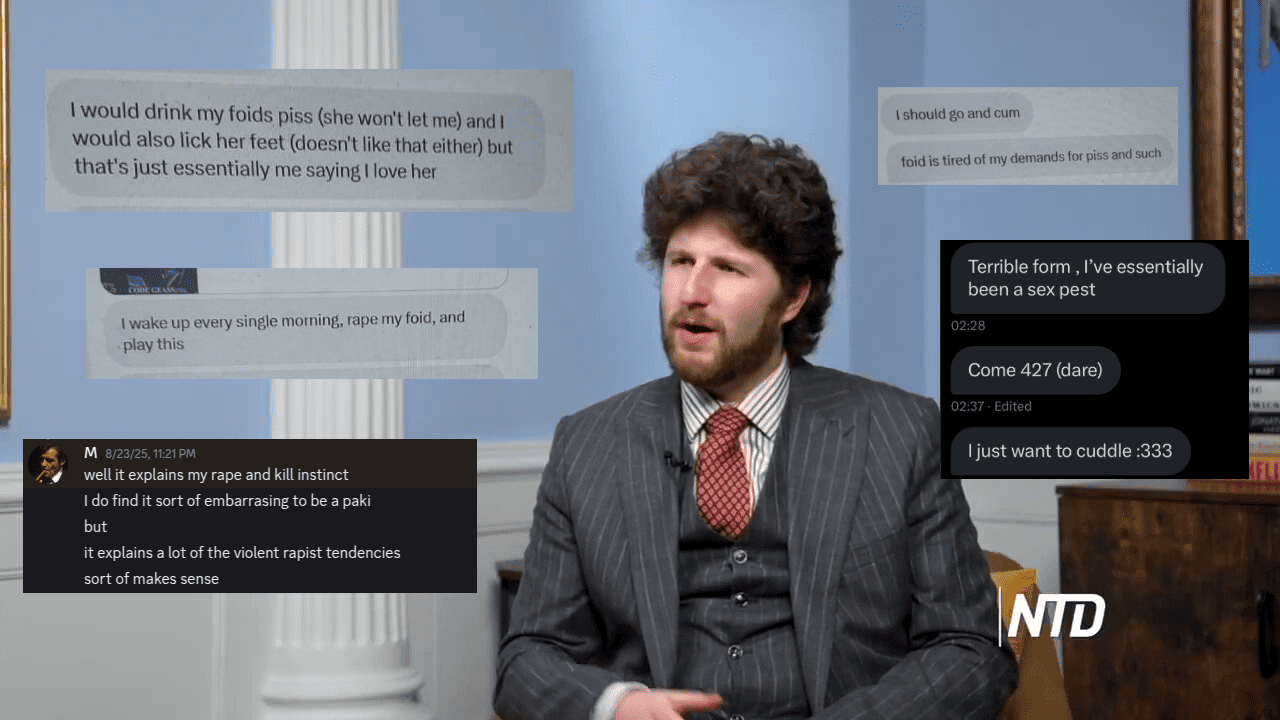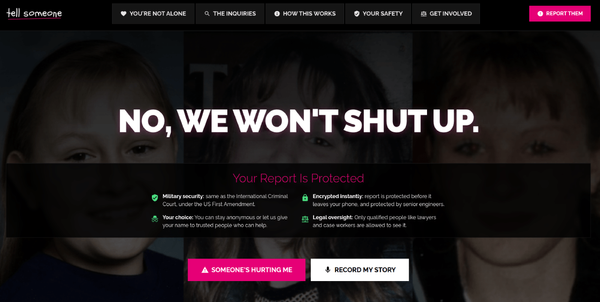Meet The Father Of Hate Not Hope: Gerry Gable

So "Hate Not Hope", aka "Searchlight Information Services", are at it again. This time they've doxxed another individual YouTuber with the wrong opinions after a campaign of serious criminality, and libeled him with a claim he "inspired terrorism." And they're getting more daring with each dying attempt to secure more funding, through their links with the British state as the country becomes more agitated with mass immigration. This is all a historical pattern which started in the 1960s with an infamous convicted criminal named Gerry Gable, who grandfathered this repulsive organisation but parted ways with it in 2011.
But first, what is Gable's bastard child up to?
Who Are Hope Not Hate?
As America has Media Matters, GLAAD, the SPLC, the ACLU, and the ADL, the UK has its own band of moral crusaders and political vigilantes. They conduct "investigations" through illegal means to "expose" political opponents, then feed their "reports" to easily-scared, desk-bound journalists at the BBC, Channel 4, and the Guardian, who portray them as a "neutral" kind of brave "watchdog" charity working for the public good. Naturally, they hope this renders the people they don't like to the attention of the Home Office and police, where the process will be the punishment. This network of loons is firmly rooted in the dumbest corners of British humanities' departments.
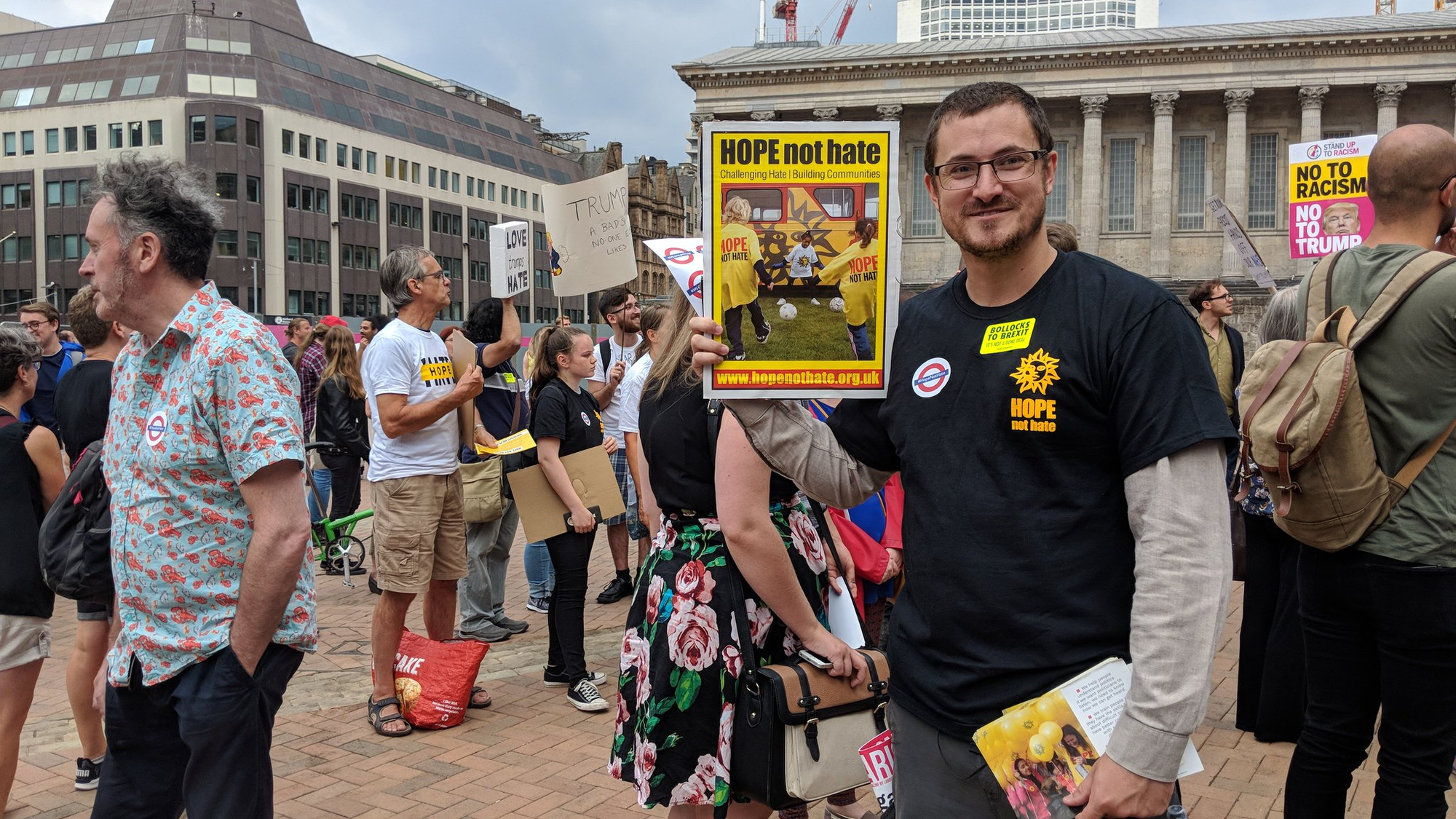
Which would be noble, if it were the 1930s, and they did expose malicious actors to end Nazism as if we were all in a magic time machine.
Associated with the ADL-like Community Security Trust (CST), bankrolled by donations, the Soros Foundation, and the Paul Hamlyn Foundation Migration Fund, this organisation - almost certainly a cutout proxy - consists of multiple (re)named parts, which absolutely stinks of laundering:
- Searchlight Information Services (SIS, founded 1986), interesting synonym of Britain's foreign intelligence service, and HNH's apparent precursor organisation
- Hope not Hate (1986) Limited (Reg. No. 02055070)
- Searchlight Educational Trust (SET), a charity registered No. 1013880 in 1992, later renamed to Hope not Hate Educational
- Hope not Hate charitable trust (Reg. No. 1013880 and 02738367)
- Hope not Hate Educational Ltd, with an address given as PO Box 67476, London NW3 9RF
- Hope not Hate Limited (Reg. No. 08188502).
- Hope not Hate (Services) Limited (Reg. No. 07719229)
- Partnership with the School of Social Sciences at University of Northampton to house the Searchlight Archive
- Apparently a background organisation called the Trade Union Friends of Searchlight
It is headed by Nick Lowles MBE (nickname "Penfold"), a former student volunteer at Sheffield University, former editor of Searchlight magazine, former head of campaigning at SEED. And a former Panorama TV researcher, which, as we will see later, is rather coincidental and intriguing. Commentator Owen Jones is a patron of HNH’s Education Fund, as are the secretaries of the National Education Union and Unison.
- Their "Senior Researcher," and "head of intelligence," Matthew Collins, was a radical member of both the BNP & National Front (former) and a Communist Party of Great Britain member who is on video in 2013 waving a Soviet flag and praising the Red Army
- Their former "communications advisor," firebrand journalist and former GMB union official, Dan Hodges (son of Labour MP Glenda Jackson), claimed they used "every dirty, underhand, low down, unscrupulous trick in the book."
- The government has answered FOIA requests revealing they were paid by the Home Office for rather questionable invoice items, as well as the Department for Communities and Local Government
- The Economist accused them of massively exaggerating the celebration of an MP's murder by their political enemies
- The Spectator called their gangster tactics a form of racketeering and coercion
- The Critic called them the left's sponsored "attack dog"
- Left-wing Novara Media accused them of cherry-picking their opponents
- The Express implicated them in spreading an imaginary list of "far right" rioters
- Influential Whitehall blogger Guido Fawkes published recordings which appear to implicate the group in partisan violation of electoral law
- Socialist publication Notes from the Borderland claimed they were a Labour-supporting intelligence front for MI5 and Searchlight lying about founding, statistics, and even the BNP (!!!)
- The Jewish Chronicle publicised they'd been been ordered to pay damages for falsely accusing a Jewish woman of attacking a socialist bookshop
- They called for the Labour party to adopt policy from the Marxist movement, Poale Zion (see: Liron Velleman, Policy Officer for the Jewish Labour Movement), which apparently is also concerned with imaginary Nazi-satanism and even managed to make its way into MI5;s inbox
- They half-apologised for not deleting a false incitement tweet falsely suggesting right-wing protesters were acid-attacking Muslim women in Middlesborough after the police confirmed it was nonsense
- Their "reporter," alias Harry Shukman, alias “Christopher Morton”, was caught using a false UK passport and found to have paternal links to SIS
- Their former director, Ruth Smeeth MP, is on record as secretly briefing a foreign government about her own PM's intentions
- The Shawcross Review of the Home Office's Prevent program accused them of falsely conflating legitimate disagreement with extremism
- Researchers have endlessly complained they misuse their charitable structuring to campaign politically, and MPs have raised questions in Parliament
- The Telegraph cross-linked their materials to the government’s Research, Information and Communications "propaganda" unit, set up in 2007 by a former MI6 officer
- They claimed to have inside information about MI5 informants spying against them
- Collins apparently traveled in a "convoy of cars" controlling 25 spies/collaborators
- Their "director of research" accused Elon Musk of supporting neo-Nazis
- They have campaigned for extensive government censorship in Parliament
- They have shared false claims 14,000 babies would die in Gaza (p. 9)
Naturally, the snake has come to eat its own tail many times, after falsely dishonouring their own artist award winner and Lowles being kicked out of NUS events for disliking Arabs while being Jewish.
According to Hate Not Hope, the right hand has no real idea what the left hand is doing:
HOPE not hate [limited company] receives grants from HOPE not hate Charitable Trust, which are used to undertake work falling within HOPE not hate Charitable Trust’s charitable objects.
https://hopenothate.org.uk/hnh-charitable-trust/
The Charity Commission’s “Speaking Out” guidance (CC9) explicitly instructs charities campaigning (or any public statements) must “comply with charity law, and other civil and criminal laws” and be “factually accurate.” In fact, the Commission warns that “any event or publication must not breach criminal law, equality law or defamation law”, and knowingly publishing defamatory lies breaches trustees’ duties. In regulatory practice, misconduct includes any act a person “knew (or ought to have known) was criminal, unlawful or improper.” If the charity’s trustees authorised or ignored these actions, they could face sanctions: an official warning, inquiry, or removal from office. Serious breaches (e.g. bribery, harassment, defamation) could even trigger disqualification of trustees under the Charities Act. Moreover, charities must remain non-partisan. The Commission have made it clear the use of charitable trusts for extremism is unacceptable. In fact, in 2017 they had cause to advise/warn HNH about political activity.
This isn't a partisan issue: there are multiple organisations on both sides who abuse this loophole to raise money for their nefarious activities.
In July 2024, they claimed to have cyberstalked pictures uploaded by the pseudonymous account "Raw Egg Nationalist" (Charles Cornish-Dale) and identified the location of a local farm shop. This somehow involved Katherine Long, a "journalist" for Business Insider, who harassed the owner asking for information on the man doing his shopping there. Long's background indicated her as a quite obvious intelligence plant, making the claim about social media imagery highly suspicious.
The doxxing of REN (Charles) followed that of Bronze Age Pervert (Costin Vlad Alamariu) and Lomez (former University of California, Irvine lecturer Jonathan Keeperman).
Later that year, when Channel 4 produced an absurd documentary lionising a pitiful "investigation" into a little known group, Connor Tomlinson (Lotus Eaters)meticulously documented how one of their staff (Shukman) had produced what appeared to be a genuine British passport with a false name to enter their event. Which was either a criminal act of possessing false identity documents, or something actually issued by HM Passport Office: something only possible when requested by the intelligence services.

So what is this time?
An "undercover reporter" from Hope Not Hate fraudulently gained access to a private Scyldings event in Oxfordshire, searching for the name behind anonymous account "Morgoth Reviews." They then proceeding to illegally photograph (GDPR) attendees who expected it to be private after noting the man's name. According to the individual, Hope Not Hate staff turned up at an old residential address posing as journalists looking to interview a YouTuber. Not finding much luck, they went back the next day to harass neighbours door-to-door, and post letters under doors offering money for documents on him.
The result was an insanely libelous article accusing him of "inspiring terrorism."
None of these people belong to any extremist organisation, nor have any of them committed any kind of criminal offence.
1950s: A Communist From The Beginning
Gerry Gable was born on January 27 1937 in East London. As a young man, he joined the Young Communist League and the Communist Party of Great Britain, where he worked as a runner for the Daily Worker newspaper (now Morning Star) and later as a trade union "community organiser."
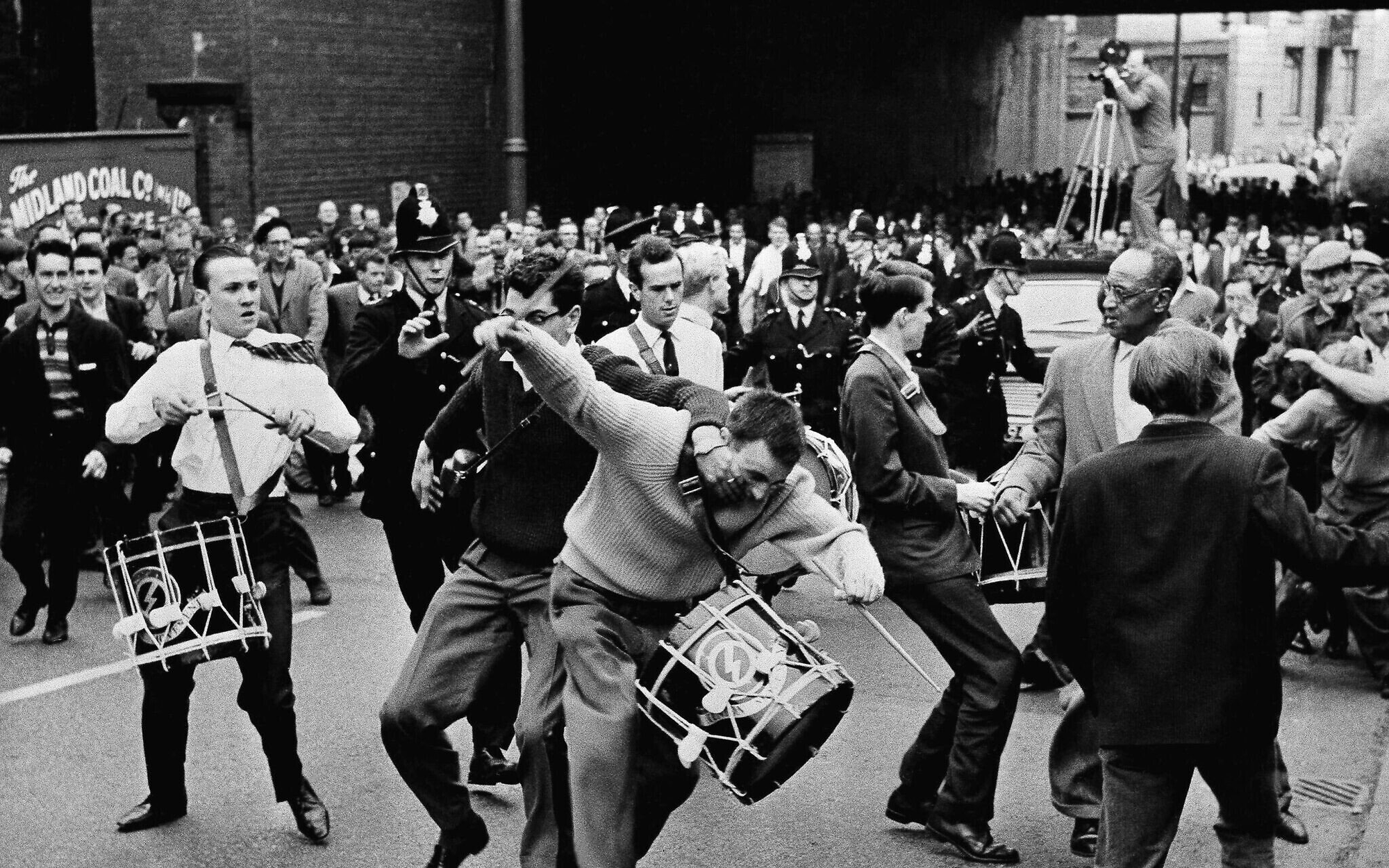
In 1962, he ran unsuccessfully as a Communist Party candidate in Northfield Ward, Stamford Hill. After 10 years he left, wanting to "concentrate on anti-fascist work and because the party had begun to adopt an anti-Israel line," and in his own words, considered himself to be “first and foremost a Jewish trade unionist.” It wasn't to last, because communists are communists. And they've been calling themselves "antifascists" for a century.
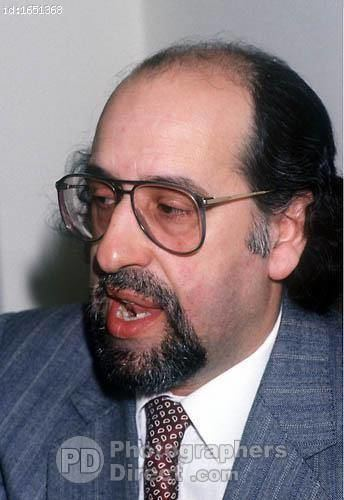
Around the same time, 4 organisations were ruffling feathers about Commonwealth immigration into Britain:
- the National Socialist Movement (Colin Jordan)
- the Union Movement (Oswald Mosley)
- the British National Party (BNP)
- the National Front
Harry Bidney, the gay owner of "The Limbo," a nightclub in Soho, formed a Jewish-only group named the "62 Committee" from former members of the "43 Group," the Spanish International Brigades, and the "Yellow Star Movement." It was composed of supporters of the Beginite Herut organisation, a political successor to the Irgun Zvai Leumi terrorist group.
The exclusive group decided to meet fire with fire, engaging in violence, infiltration, and take revenge for WWII.
The Board of Deputies of British Jews denounced what became known as the "62 Group." The Remnants became the Community Security Trust in 1975.
Gerry Gable signed up, and was their "intelligence officer." Searchlight themselves chronicle their long history on their own website.
Bidney's story is extraordinary and only came to light in 2012.
During the period from when I first met Harry Bidney until the Brighton fiasco, he had two Special Branch handlers, one of whom became the head of Special Branch. They would visit him two or three times a month. He told me who they were after a time so that I could give them a message if he was not around when they came.
https://www.infotextmanuscripts.org/searchlightarchive/s_a_brief_biographies.html
1963: Burgling David Irving's Home
Gable and two accomplices gained entry to the home of historian David Irving in Hornsey by posing as GPO (General Post Office) telephone engineers to steal documents.

As Gable tells it, he and other young anti-fascists [communists] were deeply concerned at the kind of material Irving was producing in his early books, and, aware that Irving had spent time working in the Krupps steel mills in Germany, were convinced that the writer was getting help from some unsavoury sources.
“It became more obvious, as he had access to documents that no-one else had — and with the kind of work he was doing for Krupps, he didn’t have time to go to archives and do the type of detailed research necessary.”
With two other men, Gable devised a plan to enter Irving’s home, posing as a telephone engineer. He was genuinely working as an electrician and trade union organiser at the time, and decided his cover story would be the need to rewire Irving’s phone for a different voltage.
Unfortunately this had actually taken place in the neighbourhood six weeks earlier, and Irving, having let two of the three men into his flat, grew suspicious.
He said he was popping out for cigarettes, but returned bearing a hammer, saying: “I think you should know I’ve called the police.” Gable meanwhile had found disturbing material in Irving’s flat and invited the police who arrived to arrest him.
https://www.jewishnews.co.uk/gerry-gable/
In January 1964, Gable was convicted of a much lighter sentence of “entry by artifice,” fined £20, with an additional £5 for theft of a GPO pass. As part of his defence in the 1963/4 burglary trial, he admitted he hoped to supply information to Special Branch on David Irving.
1964: Searchlight Magazine
The 1960s and 1970s saw a surge in underground newspapers tied to the counterculture, New Left, and anti-war movements, which indirectly competed for readership among progressive audiences. Its history is catalogued extensively by author Tony Greenstein.
In the mid-1960s, Gable co-founded Searchlight as a newspaper alongside Labour MP Reg Freeson, Labour MP Joan Lestor, and sports journalist Maurice Ludmer, with Gable serving as "research director."

Ludmer was the first editor and a member of the steering group of the Socialist Workers Party (SWP)'s first Anti-Nazi League, which later became Unite Against Fascism.
During that time, a myriad of newspapers went head to head for dominance on university campuses and other battlegrounds:
- Private Eye launched in 1961 as a satirical take on politics and society
- Bulldog was the magazine of the Young National Front, edited by Joe Pearce, running from the late 1970s to the mid-1980s. It promoted far-right activism, particularly on football terraces, and idealised the white power music scene. The magazine was openly racist and incited violence, positioning it as a direct ideological opponent to Searchlight.
- Lobster, a journal focusing on intelligence services, political conspiracies, and parapolitics, emerged in the 1980s but had roots in the 1970s countercultural and investigative journalism scene. It hated Searchlight.
- Black Dwarf was a socialist and New Left publication (1968–1972), addressing racism and imperialism.
- The Campaign Against Racism and Fascism (CARF), initially an insert in Searchlight from 1979, was published by the London Anti-Racist Anti-Fascist Co-ordinating Committee, but with a stronger focus on old school racism. They hated Searchlight for focusing too heavily on antisemitism at the expense of addressing anti-Black sentiment.
- The International Times (IT), launched in 1966, was a leading underground paper covering countercultural topics like music, drugs, and radical politics.
- Oz was known for its provocative content and legal battles over obscenity in the early 1970s, Oz targeted a youth audience with radical and libertarian views.
In the 1970s, Searchlight focused on demonizing the Conservative Monday Club, and in the 1980s, it targeted the Western Goals Institute (later linked to the Traditional Britain Group).
In 1981, associated journalist, Manny Carpel, was jailed for burning down the Hancock printing press.
Lobster’s 1992 issue (reprinting a 1980 New Statesman article, "Destabilising the “decent people”) questioned whether Searchlight, under Gable’s leadership, served as a conduit for state surveillance of extremists.
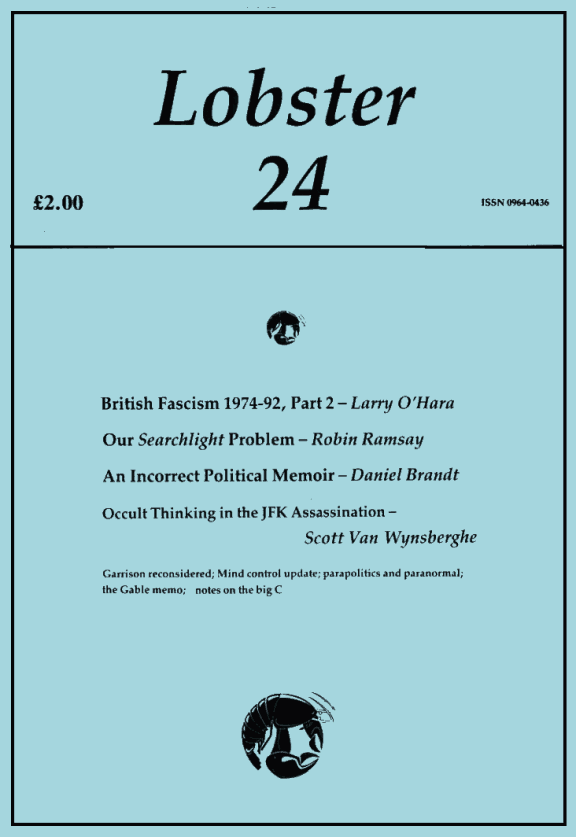
Even its most vocal left-wing supporters denounced its behaviour. In the 90s, the anarchist Direct Action Movement (DAM, aka Syndicalist Workers Federation, Solidarity Federation, International Workers' Association), which spun off from the violent Anti-Fascist Action, were questioning what it was doing. Both were linked with Red Action and the 1987 Red Front.
In 1991, the shareholders of Searchlight Magazine Limited were: Gerry Gable, Stephen Silver, Michael Billig, David Edgar and Elizabeth Ludmer. The directors of the Searchlight Educational Trust were Kenneth Leech, Dr Anthony Kushner, Baron Moss (now deceased), Carrie Supple, Robert Purkiss, David Herman, and Mrs Sonia Gable.
In 1999, Nick Lowles - the CEO of Hope Not Hate - became editor of Searchlight.
1975: Mystical "Column 88" Appears
The official story goes something like this.
During the Troubles in Northern Ireland, Column 88 was formed as a British neo-Nazi paramilitary known for its secretive operations and alleged ties to figures like deputy direct of MI6, George Kennedy Young (chair of the Monday Club). As a football hooligan movement, it aimed to revive fascist ideals, reportedly celebrating Adolf Hitler’s birthday and engaging in paramilitary training. Searchlight magazine, with Gable as editor, exposed Column 88 in its May 1975 issue, relying heavily on information from infiltrator Dave Roberts. Gable claimed National Socialist leader Colin Jordan was sworn in as a member of this secret society at 19. The "88" derives from Heil Hitler initials (H=8, H=8).
"Column 88" allowed the Tory government to bring in new laws to fight 'racism' as defined in the onerous Public Order Act 1986 and also draw in massive donations to Searchlight to fight the 'Nazi menace of Column 88'.
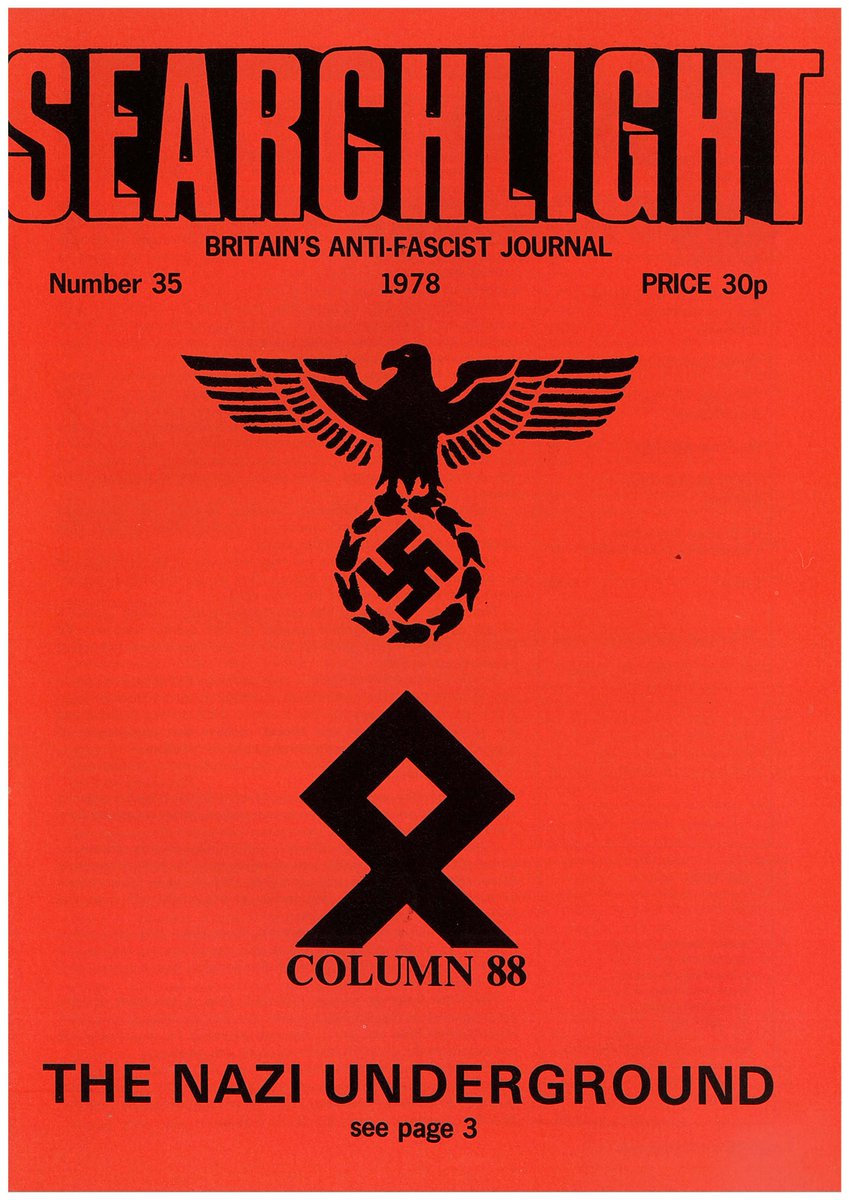
However, radical left wing groups - on Gable's side, generally - were deeply suspicious. Lobster magazine, was particularly irritated. Right wing groups cried foul.
Larry O’Hara’s Searchlight for Beginners (1996), published by Lobster magazine, argued it was not a legitimate neo-Nazi group, and that Searchlight, under Gable’s leadership, played a pivotal role in promoting its exaggerated threat to serve state interests.
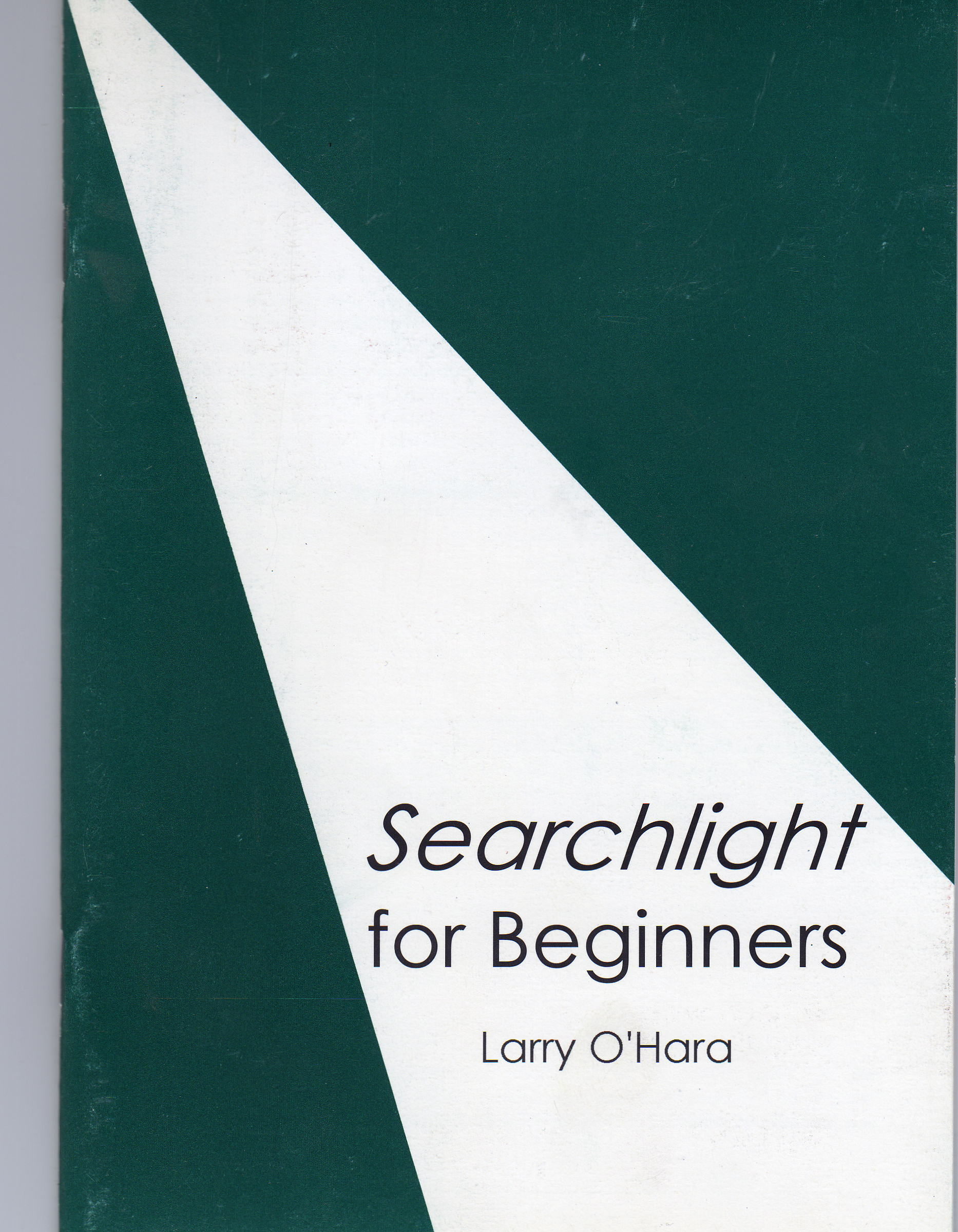
O’Hara claims C88 was a British intelligence operation designed to attract and monitor far-right extremists, not a genuine fascist group. Searchlight’s 1995 Community Handbook later admitted C88 was a state “honey trap,” possibly linked to the Gladio network, but O’Hara argues Searchlight failed to disclose this during C88’s active period, thus aiding the state’s deception. He contended this coverage, reliant on infiltrator Dave Roberts, was orchestrated to create a public scare, diverting attention from more significant state activities, such as MI5’s efforts to undermine Labour PM Harold Wilson. The 1976 Savernake Forest story, linking C88 to Territorial Army exercises, further amplified its threat, with Searchlight boasting of its scoop while omitting Roberts’ ties to Special Branch.
Gable’s key operative, Dave Roberts, a former communist party member, provided critical intelligence on C88. After joining the National Front in the Midlands under the pseudonym "Ralph Marshall," he was arrested in 1976 for attempting to assault an Indian restaurant staff and arson on Communist Party premises. Roberts passed information to Special Branch, which O’Hara saw as evidence of his status as a state asset. Gable’s future wife, Sonia Hochfelder, played a dubious role by passing information on leftist groups (e.g., CPE-ML) to fascists like Steve Brady, potentially contributing to the 1975 murder of IRSP member Michael Adamson by the UVF in Northern Ireland.
A quick read of left-wing suspicion makes it clear why they were so agitated:
Amongst the information passed to Searchlight in 1976 by Roberts (who was subsequently disowned by Gable after Maurice Ludmer's death), was the revelation that David King (a Birmingham Nazi known to have close links with the so-called "Column 88") had told Roberts in prison that he suspected fellow fascist Peter Marriner of being in touch with Special Branch. Marriner, a long-time Nazi activist in Birmingham, then local organiser for the British Movement and said to be involved with "Column 88", achieved notoriety when he was exposed as a fascist infiltrator of the Labour Party, International Socialists, and other left-wing groups during the Ladywood bye-election. Searchlight subsequently printed a long expose of Marriner's activities, but only after the local press had already picked up the beginnings of the story and blown Marriner's cover as election agent to Labour MP Brian Waldon and his successor, John Severs. Nowhere in Searchlight's coverage of the Marriner case was there any mention of a Special Branch connection. Marriner told the Left he was infiltrating the Right. He told the Right he was infiltrating the Left. If he was also in contact with Special Branch, just who was infiltrating who? And why, after they published so much else of the information gathered by Roberts, did Searchlight balk at exposing a leading Birmingham Nazi as an agent of the Special Branch? With "experts" like Gerry Gable, who needs fascists?
https://www.katesharpleylibrary.net/wwq0mz
1977: Boasting of MI5 Links At LWT
By now, Gable had aroused the suspicions of almost everyone in terms of his links to the state intelligence services. Rather hubristically, he confirmed them in writing.
Gerry Gable, is a self-confessed confidant of Special Branch. As has been demonstrated in earlier reporting (see Anarchy magazine) Gable and colleagues were able to get much of their information on British based fascists direct from police intelligence. The traffic was by no means one way.
https://libcom.org/article/anti-fascist-or-pro-police-anarchist-black-cross
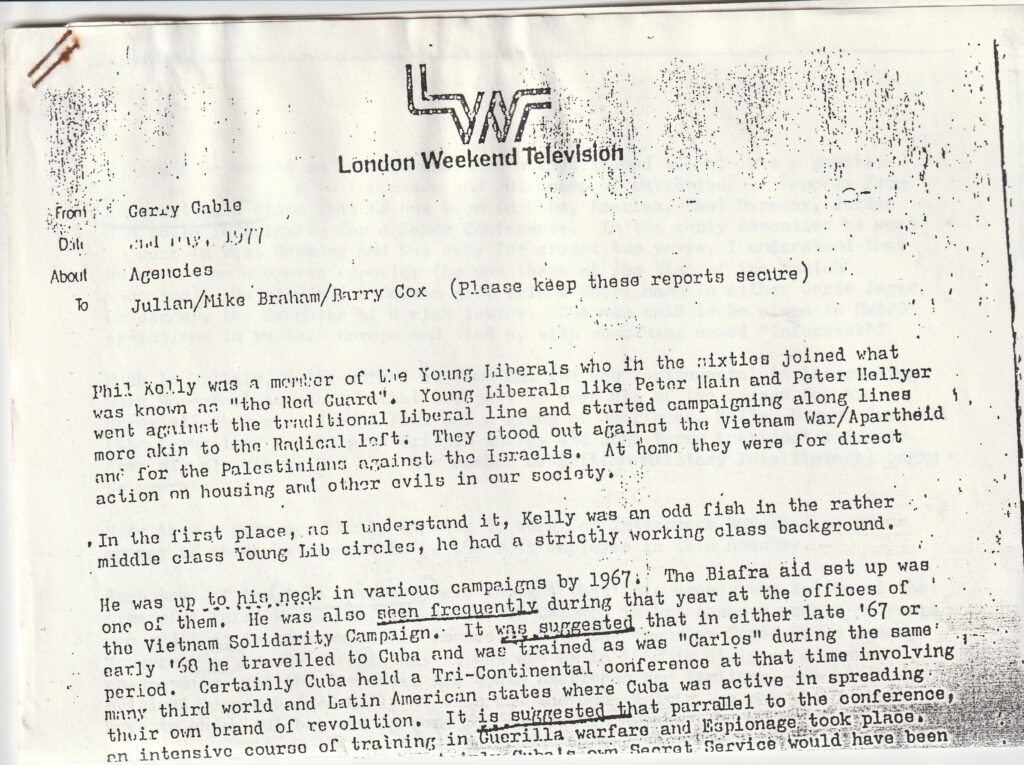
In May 1977, Gable was working at London Weekend Television (LWT), as a researcher/presenter on the London Programme. Notes from the Borderland - a leftist publication - explicitly details it the full "Gable Memorandum":
I have now given the names I have acquired to be checked out by British/French security services, especially the French and German connections and the South American stuff is being checked by Geoffrey Stewart-Smith’s institute. He has strong CIA links. I may try somebody in the Israeli Foreign Office that I know for some checks on Kelly. It is now a time of waiting for feed-back and also further checks here.
https://borderland.co.uk/gable-memo-proving-mi5-links/
Anarchist author Kate Sharply, aforementioned, documented the memo in meticulous detail:
The memo was the subject of an article by Duncan Campbell and Bruce Page in the New Statesman in February 1980. Gable has never successfully refuted the information contained in the article. When Campbell and Page went down to LWT's offices to confront Gable with the evidence and demand some answers, Gable simply cleared his desk and fled, refusing to talk to them. This is in marked contrast to his previous meeting with Campbell, whom he took out to an expense account lunch during the 'ABC' Official Secrets case to pump him for information he could pass on to his friends in Special Branch.
The memo, written by Gable followed, he says, a lunch with a Security Service employee in May 1977. The nature of the official material received and recorded by him - mixed with large amounts of random gossip - indicates that much of it was coloured by phone-tap information and informer's reports. It consists almost entirely of libellous untruths about a group of 'target' individuals the 'ABC' Official Secrets defendants, American deportees Philip Agee and Mark Hosenball, and several of their acquaintances. In certain respects, material from Special Branch had been deliberately falsified to mislead Gable and his employers. The timing of the memo showed clearly an intense interest on behalf of MI5 in manipulating events surrounding the Agee/ Hosenball case and the beginnings of the 'ABC' prosecution.
https://www.katesharpleylibrary.net/wwq0mz
A profile of Gable in the Jewish Chronicle, October 23, 1987, said of Searchlight, 'The magazine has a small staff, but its stories, gleaned from a wide range of contacts (including people in the secret services)...'
1984: Libeling Tory Politicians Via The BBC
In the 80s, Gable really ramped it up. The BBC commissioned him to produce research for a BBC Panorama programme "Maggie's Militant Tendency" about right-wing extremism in the Conservative Party. One should know by now where this is heading.
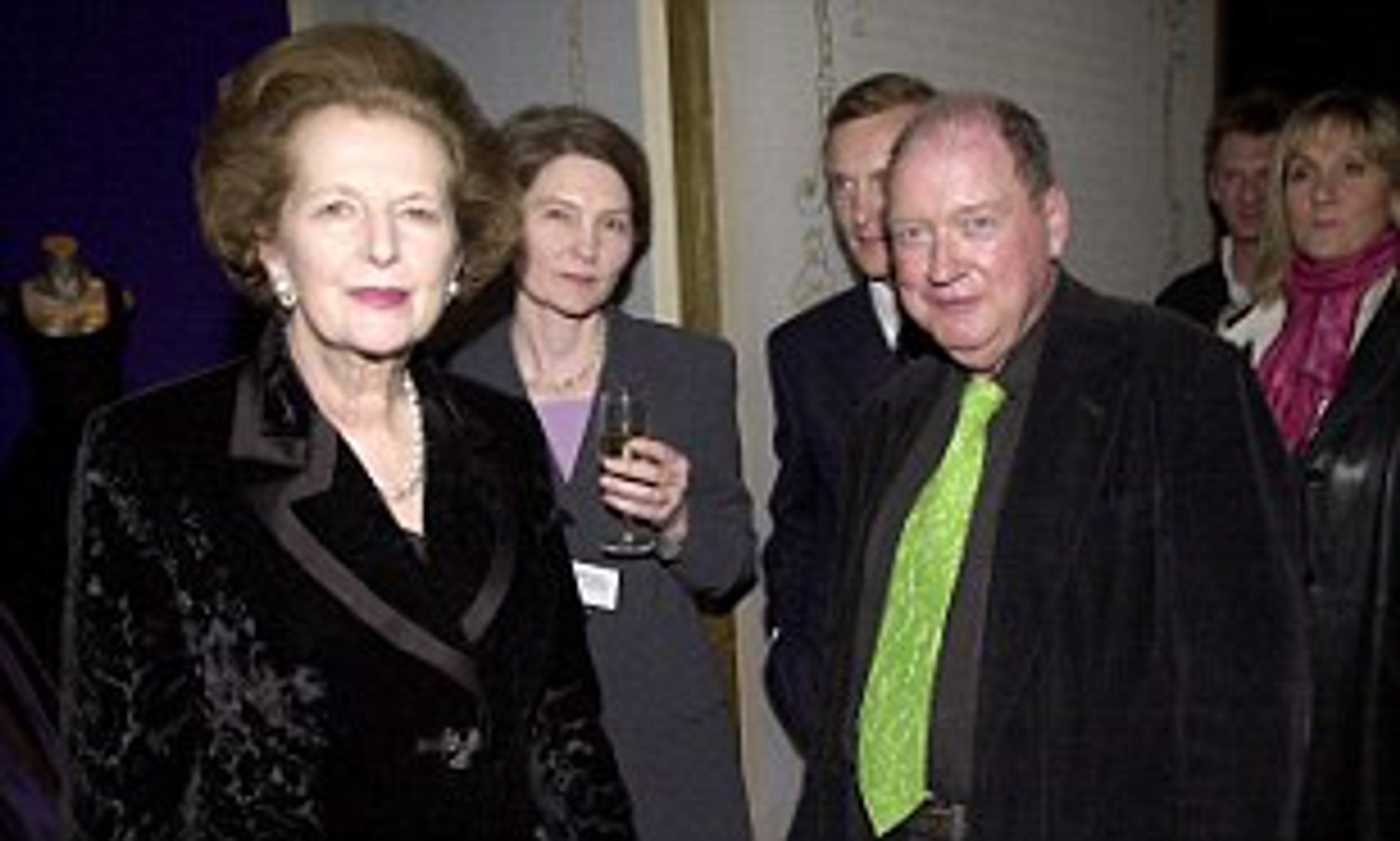
He didn't disappoint. He alleged two Conservative Party figures, Neil Hamilton and Gerald Howarth, were secret extremist Nazi supporters on the basis Hamilton allegedly gave a Nazi salute in Berlin while 'messing around' on a Parliamentary visit in August 1983.
Hamilton and Howarth settled at £20,000 each for libel, with the case funds raised by chairman of the Institute of Economic Affairs, Ralph Harris, and Sir James Goldsmith. It was followed by a Commons motion signed by 100 Tory MPs calling on the Director-General Alasdair Milne to resign.
The same year, "Searchlight Information Services" (SIS) was created as a research and investigative body to gather and analyse intelligence on fascist, Nazi, and racist organizations. It provided briefings to governments, politicians, journalists, and police, expanding Searchlight’s influence beyond the magazine.
Small breadcrumbs were left around the old magazine presses about this individual:
He also hinted once again at the alleged Michael-Somoza relationship. In 1986 Michael had been involved with the final re-launch (so far) of International Times, in the March 1986 issue of which the questions of Gable's relationship with the British state had been referred to again. Atkinson referred to International Times at that time 'operating out of an office near Charing Cross, the set-up had an agent of the Somoza family hanging around'.
https://www.scribd.com/document/126084982/Lobster-24
1986: Private Eye Pays Out For Libel
The April issue of Searchlight ran the headline: "EXPOSED! TORY MP IN PLOT TO MURDER SEARCHLIGHT JOURNALIST." A “plot” allegedly to kidnap and murder Gerry Gable.
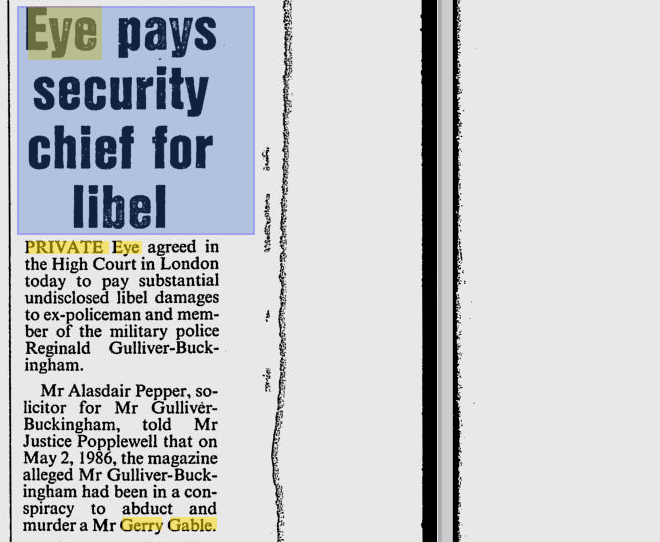
The magical story was Reginald Gulliver-Buckingham, a member of the military police, had plotted to abduct and murder Gable. It was nonsense.
In its 29 May 1987 issue, the article "MR GERALD HOWARTH APOLOGY" stated that following legal proceedings, substantial damages were paid. In its 22 Dec 1989 issue, it published "Reginald Gulliver-Buckingham An Apology," which stated that in the High Court, Private Eye apologised to him. In its 7 June 1991 issue, "MR JAMES ROSS," which announced the magazine paid him substantial damages and legal costs.
1992: Mystical "Combat 18" Appears
"Searchlight Educational Trust" (SET) was formed in 1992 as a charitable entity (No. 1013880), SET focused on educating the public about the dangers of racism and fascism, particularly in schools and communities. However, another enduring mystery concerned a similarly-named paramilitary fascist organisation which had emerged mysteriously through a scoop by Searchlight. The official story goes something like this.
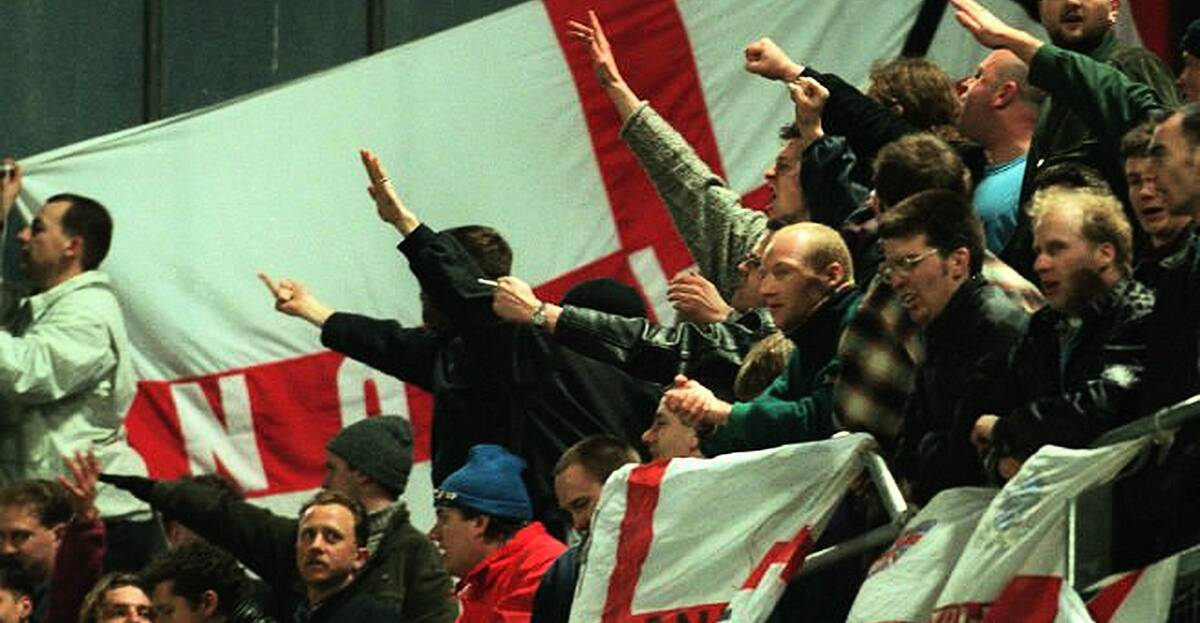
In 1992, Charlie Sargent and American Harold Covington, formed an offshoot of the British National Party to protect its members from violent "antifascists" (communists).The "18" derives from Adolf Hitler's initials (A=1, H=8). In the early 1990s, C18 gained notoriety for street violence and publishing Redwatch, a magazine listing personal details of political opponents to incite attacks. By 1993, it began forming ties with other far-right groups in Europe and North America. In 1997, internal conflicts led to Charlie Sargent’s conviction for the murder of fellow member Chris Castle, causing a split within the group.
During the late 1990s, C18 was linked to violent incidents, including the 1999 London nail bombings by David Copeland, a former member. The group’s activities included distributing bomb-making manuals and planning attacks to destabilise multicultural societies. It also identified C18 members in the British military, including soldiers from the Parachute Regiment whom it claimed were far-right paramilitary terrorists.
Sargent split with his former C18 colleagues over allegations - yet again - he was an informer for the British security services. A feud had began in 1996, which the left-wing site Statewatch narrates well:
The fascist organisers were jailed for life after a jury found them guilty of stabbing to death Blood and Honour supporter, Christopher Castle, who was acting as an intermediary between the rival groups. The court heard evidence from a number of key C18 members as the supporters of the factions issued threats and accused one another of "grassing" to the police (see Statewatch, vol 7 no 2).
The feud between Sargent and another C18 leader, who cannot be named for legal reasons, began in the autumn of 1996 and centred around money and control of the lucrative CD music business. Disagreements led to Sargent making allegations of the theft of up to £100,000 against his former partner. As the accusations became more acrimonious they led to a split in the movement and the formation of the Sargent-led National Socialist Movement (NSM). Sargent's rival, along with other key players, maintained control of the C18 faction.
In February 1997 Castle agreed to act as an intermediary between the warring factions. It was arranged that he would deliver Sargent's work tools to the Harlow home of his girlfriend and in exchange he would receive the C18 mailing-list and £1,000 from Sargent. However, Sargent had other ideas and with his close friend, Blood and Honour organiser, Martin Cross, plotted to ambush Castle.
Castle was accompanied by the C18 leader, who he dropped off outside the rendezvous, before meeting Sargent. A short time afterwards, the court was told, Castle staggered out of the house shouting for help. He had been stabbed in the back by Cross, at the instigation of Sargent, in what was described as "a violent and cowardly attack". The C18 leader hailed a taxi and took Castle to a hospital where he later died.
https://www.statewatch.org/statewatch-database/uk-c18-leaders-get-life-for-murder/
In May 1993, Searchlight submitted written evidence to the UK Parliamentary Home Affairs Select Committee, describing C18 as a terror group possibly linked to South African state security services (via Ray Hill). In December 1993, Gable gave verbal evidence to the committee, urging MI5 to take the lead in investigating C18 due to its alleged connections with Northern Irish loyalist ("terrorist") groups like the Ulster Defence Association (UDA), i.e. Terry Blackham’s 1994 attempt to supply submachine guns and a rocket launcher.
It had two key informants within far-right groups: Tim Hepple, associated with the BNP, and Matthew Collins, linked to the National Front and C18 (later Hope Not Hate's "director of intelligence'). Hepple simultaneously targeted leftist groups like Green Anarchist. appeared on an ITV World in Action documentary in 1993 (“The Terror Squad”), produced in collaboration with Searchlight, exposing C18’s violent activities, including death threats, beatings, letter bombs, and arson. Collins, who provided insights into C18’s leadership and its UDA connections, faced suspicion and was relocated to Australia by Searchlight for safety.
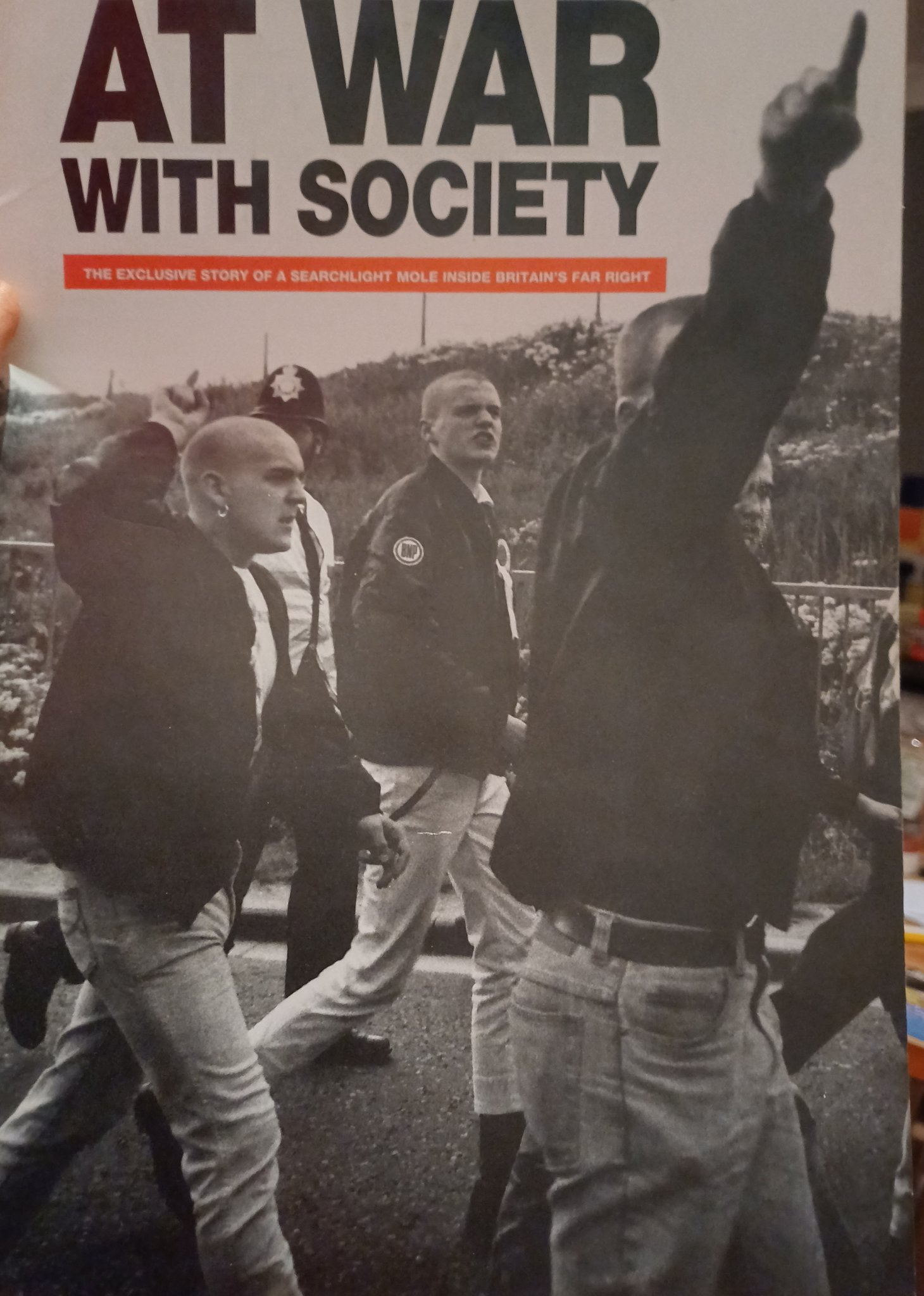
A second documentary in 1998, following Charlie Sargent’s murder conviction, revealed a thwarted assassination plot against a World in Action journalist, Quentin McDermott, based on intelligence from informant Darren Wells for nearly five years, revealing internal operations and plans.
Except, yet again, everyone cried foul this time. It was alleged to be another "honey trap" - an operation designed to attract and identify extremists.

Hepple openly claimed to work directly for MI5 and that he had witnessed British Army death squad executions in Northern Ireland.
In 1991, alongside Searchlight informant Ray Hill (a founder of the 1982 British National Party), Hepple attempted to influence Green Anarchist by offering arms and high-tech communications equipment. Hr provided lists of fascist names and addresses, many inaccurate, claiming the BNP had published leftist membership lists (e.g., in Class War and Red Action). O'Hara contends it was a lie intended to provoke leftist attacks on fascists, potentially sparking retaliatory violence. Hill revealed himself to be a "mole" in 1984 in a documentary for Channel 4.
Hepple deliberate passed the same inaccurate fascist hit lists to anarchist Tim Scargill, who published them. Searchlight later denounced these lists as “ludicrously inaccurate” and suggested Scargill might be a “sloppy nazi infiltrator” or “state agent provocateur,” despite Hepple admitting Searchlight’s knowledge of the lists’ production. He was involved in organising a race riot in Dewsbury in 1989, infiltrating Left-Green groups to steal or access membership lists and petitions, and setting up a UK newspaper for the US-based Church of the Creator, which included weapons and street warfare training.
The argument about C18 from Searchlight up to this time was quite clear, almost consistent. It was portrayed as a group of Nazi thugs, acting autonomously, who had nonetheless been inspired by US Nazi Covington (definitely) and South African Intelligence (perhaps) Their activities were worrying because of links with Ulster Loyalists. Special Branch, with whom Searchlight worked closely in the 1970's when the key inter-agency rivalry was MI5 versus MI6, had by now entered into a 'turf war' themselves with MI5. This reached something of a crescendo with the April 1992 achievement by MI5 of wresting primacy in Loyalist and Republican 'terrorist' matters from Special Branch. In this situation, twilight operators like Searchlight were faced with something of a choice to make as to which side to back in this new inter-agency conflict. Gable and his team unambiguously chose MI5, hence his attack on London Special Branch (the largest and most powerful) who had allegedly 'failed to comprehend the dangerous nature of groups like C18 here and abroad.'
A few days after I confronted [Searchlight office manager Tony] Robson, the April 1995 issue of Searchlight went to print, and its contents included a dizzying somersault. It was now announced that MI5 had in fact set up C18 as a 'honey trap' in order to 'know the extent of ... joint operations' between fascists and Ulster Loyalist paramilitaries. This claim has been repeated subsequently, and is still Searchlight's position. [50] In the context of Searchlight's history, and the line they propagated enthusiastically up to this point, their C18 coverage is plainly a disinformation project on behalf of MI5.
https://libcom.org/library/SearchlightForBeginnersLarryOhara2

Throughout these cases, O'Hara identifies a consistent pattern:
- Searchlight maintained close relationships with state security agencies
- They passed information between different groups (sometimes feeding intelligence about leftists to fascists and vice versa)
- They published stories with secret state agendas
- Key operatives received unusual levels of state protection
- They engaged in operations designed to disrupt and manipulate left-wing groups
In 1995, Searchlight called for banning Green Anarchist. Then it published O’Hara’s personal details, doxxing him, and falsely implying he facilitated drug deals between C18 and Ulster loyalists.
1996: Sued Into Oblivion
By the mid-90s, people really had started to have had enough. Searchlight published an article alleging a criminal conspiracy between O'Hara and two other men, stating they were "breaking criminal and civil laws with impunity" and should be "in custody."

Alexander Baron was a libertarian activist and self-published writer known for his involvement in fringe political circles and his prolific output of pamphlets and books with anti-establishment views. Alongside his associate Mark Taha, he issued defamation writs against 22 different defendants, including Gerry Gable, Searchlight’s editor and publisher, as well as printers, distributors, and bookshops stocking the magazine.
Baron tells the story in his own words about how he met Maha and first came into contact with Gable through his informant, Ray Hill:
In South Africa, Hill kept a low profile for several years before becoming a leading light in the short-lived but extremely nasty South African National Front. He returned to Britain in 1979, after jumping bail in South Africa too, (31) and ingratiated himself with the far right, eventually ending up with a fairly senior post in the British National Party. In 1984 he “came out” with a big exposé in a TV pseudo-documentary that was produced by Gable and shown across Europe. Together with other chutzpah Hill’s book, which was published in 1988, paints a picture of him as an essentially decent working man who had fallen in with a bad crowd then undergone a road to Damascus conversion. (32)
Mark Taha’s critical reading of Hill’s book cast doubt on several of his claims. When I read it I found even more errors and outright lies. Subsequently Mark and I were to re-read the book and scrutinise minutely every single issue of Searchlight ever produced and all the subsidiary pamphlets and articles we could lay our hands on. We found a mass of disinformation, innuendo and outright fraud.
https://www.infotextmanuscripts.org/baron_v_gable_1.html
The lawsuits typically alleged Searchlight’s articles contained defamatory statements, such as accusations of neo-Nazi affiliations, antisemitism, or involvement in illegal activities. Plaintiffs argued that these claims harmed their reputations, particularly for those with public or political ambitions, such as BNP candidates. Some lawsuits challenged the accuracy of Searchlight’s reporting, citing reliance on unverified sources like defectors or infiltrators. In particular, Baron accused Gable of falsely claiming credit for solving 1960s synagogue arsons and inventing details about Jewish victims to enhance his reputation.
Mr Baron, an assiduous publisher of right-wing literature, interrupted a Commons Home Affairs Select Committee hearing evidence on organised racism to serve a writ on Mr Gable. Another writ, from Mr Taha, who carries out research for Mr Baron's south London publishing organisation, names six defendants - the two bookshops, distributors and printers, and Mr Gable.
https://www.independent.co.uk/news/antifascist-articles-prove-rich-pickings-1338136.html
Baron collected thousands of pounds in out-of-court settlements from nearly a dozen defendants, including the Centreprise Trust in Hackney, which settled despite not stocking the relevant issue of Searchlight. Many cases were settled out of court due to the high cost of legal defense. Baron’s aggressive legal strategy was noted for its impact on small organisations unable to afford lengthy court battles. Legal fees and settlements forced Gable and his team to redirect funds from investigative work, weakening the magazine’s operations. Some outlets refused to carry Searchlight or similar publications to avoid legal risk. He ultimately settled with Gable for £5,000 and a published retraction, after Gable had initially fought the case vigorously using expensive legal representation.
Baron was subsequently charged with witness intimidation and making threats to kill, relating to communications he sent to Benefits Agency official Rita Broadway and police. He claimed these charges were orchestrated through Gable's connections with police. He defended himself at trial and was acquitted.
Baron went on to deliver a speech about Gable in 2010 entitled "The Biggest Liar Who Ever Walked the Earth."
2003: The BNP, the Charity Commission, and Hope Not Hate
In 2002, the British National Party had enough, and complained to the Charity Commission Searchlight's charity and its commercial entity were behaving illegally.
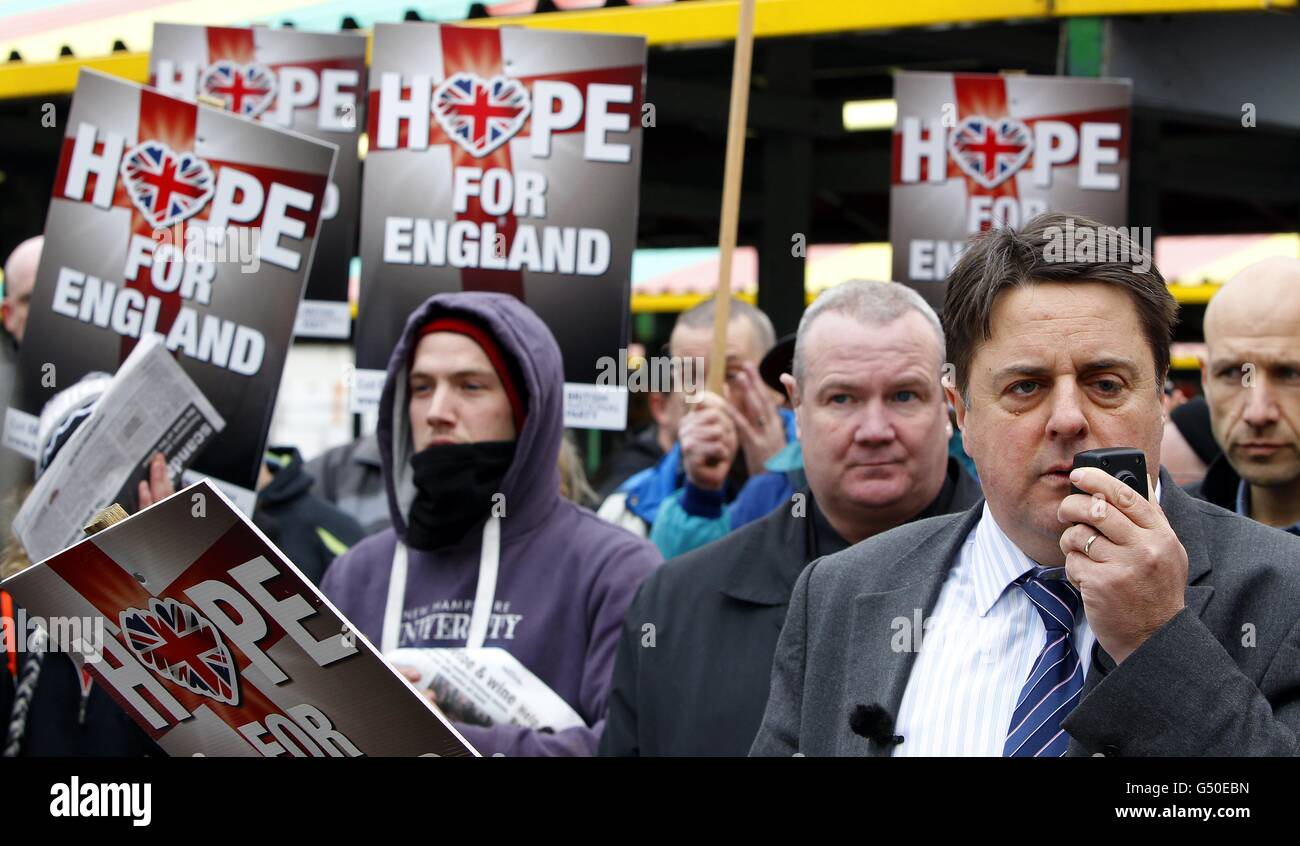
In what should now be familiar terms, the report read:
Searchlight Educational Trust ("the Charity") was registered as a charity in August 1992 and is based in London. The Charity organises seminars and produces literature for the public and its annual income is approximately £140,000. In May 2002, the Charity Commission received a complaint alleging that the Charity was carrying out political activities that were not compatible with its charitable status.The initial evaluation raised concerns about the political content of the Charity’s website, namely sections of the Charity publication "When Hate Comes to Town" (WHCTT); and also regarding the public’s confusion between the Charity and two companies – Searchlight Magazine ("the magazine") and Searchlight Information Services ("SIS"). The Commission instituted an Inquiry under section 8 of the Charities Act 1993 on 28 June 2002 with the aim of investigating whether the Charity was undertaking political activities incompatible with its charitable status.
https://web.archive.org/web/20040901203141/http://www.charitycommission.gov.uk/investigations/Inquiryreports/search.asp
The Charity Commission agreed.
It forced the organisation to divide into 3 pieces:
- Searchlight magazine
- Searchlight Information Services (SIS) - R&D (precursor to Hate Not Hope)
- Searchlight Educational Trust (SET) - the charity
Which is where Penfold took the reins.
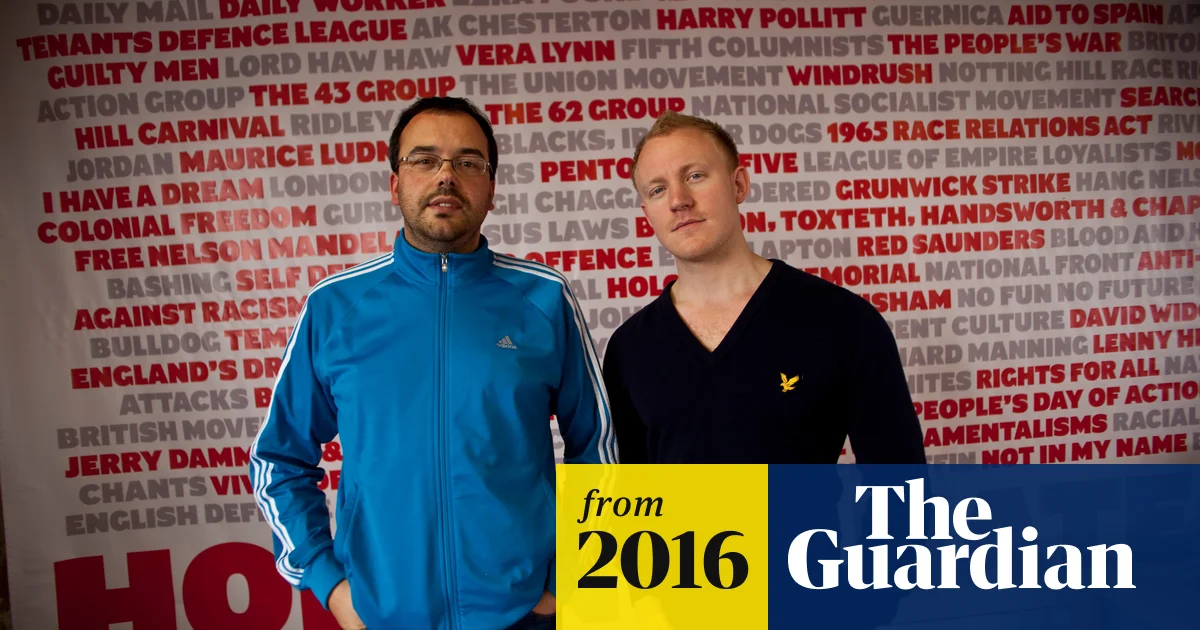
Nicholas Lloyd Martial Lowles was born at Hounslow on June 6, 1968. Also known as both "Peter Brighton" and (by his own admission) "Laurence King," According to Larry O’Hara, he was recruited from the Union of Jewish Students at Sheffield University and was once a fully paid up member of the British National Party. He took over as co-editor of Searchlight (with Steve Silver) during the Blair years, around 1999.
Some of the details of his career from FarLeftipedia might look familiar, as they are virtually identical to Gable's:
Before he became editor, he [Knowles] was an freelance investigative journalist, working in television, including on BBC Panorama, World in Action, Channel Four Dispatches and MacIntyre Undercover. The Deputy Director is Jemma Levene, who previously worked as Head of Campaigns at Jewish cultural education charity SEED, and at the Orthodox Union in New York.The Political Organiser is Liron Velleman, Policy Officer for the Jewish Labour Movement.
In 2004, the year of the charity woes, he created "HOPE not hate."
- Searchlight Educational Trust (SET) was renamed to "Hope not Hate Educational Trust" - a charity to raise money
- Searchlight Information Services (SIS) became "Hope Not Hate"- a limited company to do campaigning
- The "State of the British Right" publication became the "State of Hate" report
- Former Combat 18 informant, Matthew Collins, became its "director of intelligence"
- Magical plots to kill an MP mystically appeared from unknown organisations
- More right-wing organisations threatened to sue over claims of links to Northern Ireland
- Suspicions and accusations of it being an MI5 front organisation continued
Their mortal enemies then became the English Defence League and Tommy Robinson, along with worries about mosques and Muslim intimidation - where Lowles was disowned for being an "islamophobic" jew.
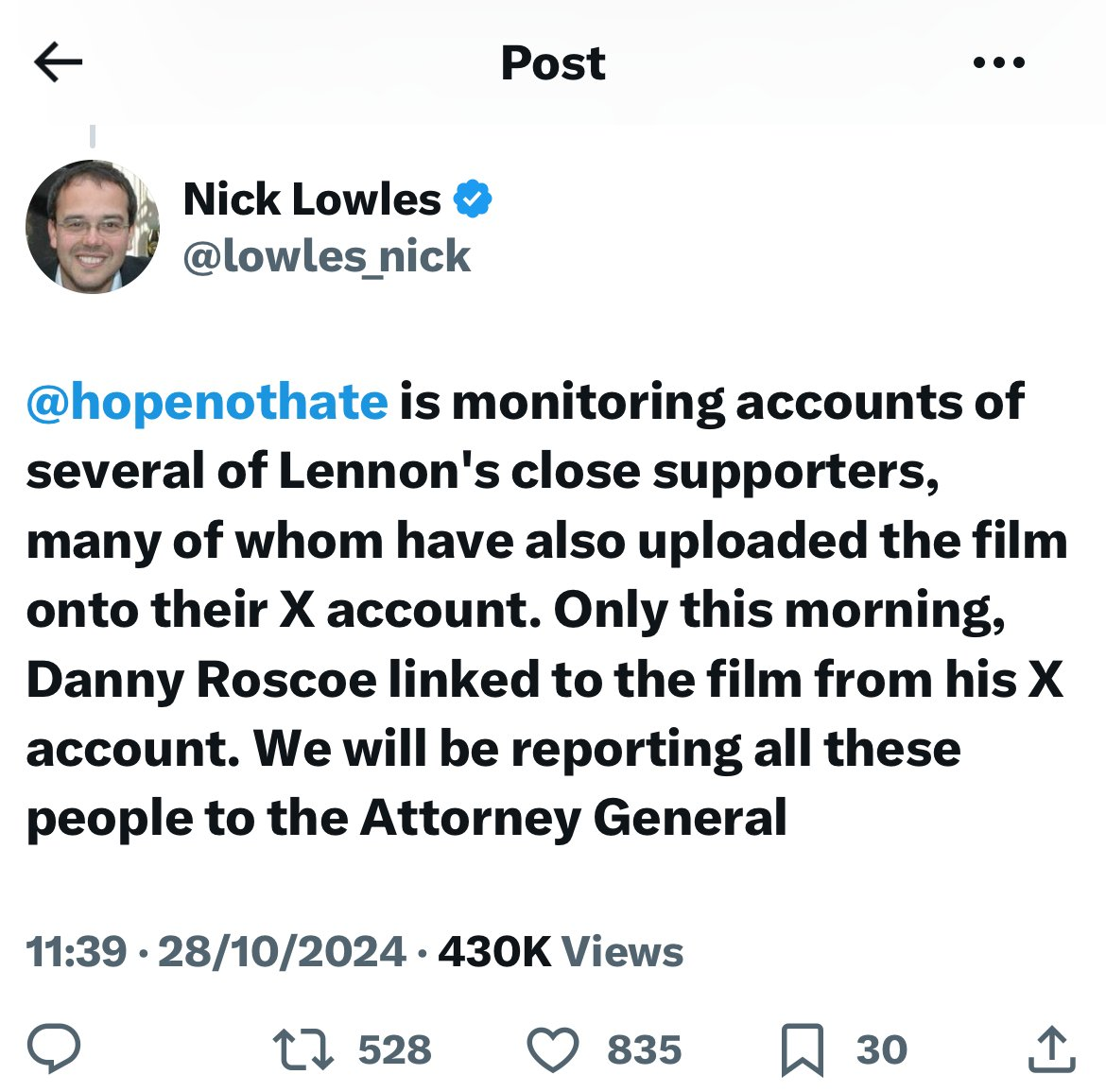
But perhaps, as we shall see, the best commentary on Hate Not Hope, aka Searchlight, comes from the radical leftist wing themselves, who hate them for being a state-sponsored operation suppressing dissent from their side of the debate, while defending their mortal adversaries, the EDL. An honest enemy is better than a dishonest friend. Why were they crying foul about this organisation in the mid-90s, despite the behaviour being targeted in their own political benefit?
In the light of Searchlight’s record on C88 alone, everything they say on the subject of security service involvement in fascist politics should be treated as disinformation, in no way as credible ‘hard’ information.
However glitzy and web-wise Searchlight’s (and even more Hope Not Hate’s) current incarnations might be, there is no getting away from it–their politics remains, as it has always been, state-compromised to the core. There are virtually no depths to which Searchlight will not stoop to undermine, spy on, and help crush genuine Leftist dissent.
.... savour this extract from the highly-publicised text ‘Searchlight for Beginners’ (visit shop, same location). This deals with the similarities between Searchlight’s two big stories/operations involving sinister far right mobilisation over the years–in the 1970s ‘Column 88’, the 1990s ‘Combat 18’. Over and aside the downright lying, mendacity and factual somersaulting revealed by these two stories alone, reading them the thought cannot failt [sic] to cross anybody’s mind–is Searchlight’s coverage of the English Defence League straightforward, and uncompromised by other agendas? We think the answer to that will be obvious. On past form, Searchlight do their best build a group up in the media and amongst potential supporters/opponents, using its activities as a reason (cover) for extending state powers, then much later purport to ‘reveal’ such a group was a honey trap for the state all along. They did this with C88 & C18, and may well intend to get away with it regarding the EDL. At the very least, an informed perusal of Searchlight’s past track record shows nothing Gerry Gable or the equally dishionest [sic] Nick Lowles say on the subject of state connections of any far right (or indeed far left) groups should be given even a morsel of credibility... A true product of what Trotsky memorably termed the ‘Stalinist School of Falsification’.
https://borderland.co.uk/our-problems-with-searchlight-hope-not-hate-2/
2011: Civil War With Lowles
But all did not go smoothly as they worked in parallel during the War on Terror and the dry spell of Nazi bogeymen.

Larry O’Hara and Heidi Svenson carefully documented what happened next for Borderline:
- Summer 2010: Secret meetings allegedly occurred between Lowles, Ruth Smeeth, and others to plan a leadership transition. Lowles claimed Gable agreed to "step aside" in 2011; Gable denied this.
- Autumn 2010: New players entered the scene, including Labour financier Richard Brindle, while Smeeth joined Searchlight Educational Trust (SET) - while giving secret briefings to foreign governments
- December 2010: Lowles proposed a new management structure with himself in overall control and Gable relegated to "Head of Research."
- March 2011: Lowles and allies directly confronted the Gables, demanding Sonia hand over Searchlight magazine shares and Gerry resign by June. They offered Gerry an "honourary" presidency and potential royal honour as consolation.
- Spring-Summer 2011: Both sides sought support from Jewish community leaders. Disputes erupted over control of bank accounts, research archives, and editorial content.
- July 2011: Sonia Gable registered "Hope Not Hate Ltd," signaling preparation for organisational separation.
- September 23 2011: Lowles resigned as Searchlight editor.
- September 24-25 2011: The Gables and associates removed 20 filing cabinets and archives from the SET offices - characterised as "liberation" by Searchlight and "theft" by HNH.
- September 27 2011: Emergency trustee meeting resulted in both Gables being fired and police being contacted about the archive removal.
Searchlight continued under the Gables with reduced resources with the University of Northampton hosting its archive of 20,000 records. Hope Not Hate is still led by Lowles with significant funding and institutional support.
Ironically, Gerry Gable is 88 years old.
Borderline's Twitter account is still hammering him.

